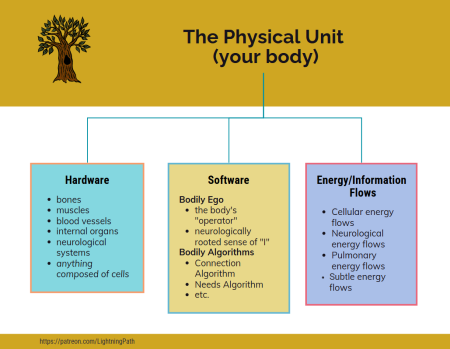Physical Unit
The Physical Unit is the physical body. The physical unit is a sophisticated "focussing device" that, when properly tuned and alignment, enables a "Full Measure" of Consciousness to express in, and operate on, physical reality.
Related LP Terms
Physical Unit > Bodily Algorithm, Bodily Ego, Connection, Seven Essential Needs, Spiritual Ego, Structure of the Human Psyche, The Blindfold, Toxic Socialization
Non-LP Related Terms
Physical Unit > Default Mode Network, Essential Needs, Health, Highest Self, Human Development, Merkaba, Needs
Syncretic Terms
Physical Unit > Physical Vesture, Temple of the Holy Spirit, The Body, The Body of Christ, The Vessel
Structure
The physical unit consists of the three integrated components, these being the
- hardware,
- software, and
- energy and information conduits that power the whole thing.
The hardware of the physical unit consists of the bones, muscles, blood vessels, internal organs, and neurological systems of the physical body. Basically, anything with a cellular structure is hardware.
The software of the physical unit consists of two things, Bodily Algorithms which facilitate operation, adaptation, and survival, and a Bodily Ego designed to do the same.
Finally, the energy and information conduits are the channels that power the whole thing.
Notes
The phrase Physical Unit (PU) refers to the physical body, specifically as it functions as a container for Monadic Consciousness. The physical unit consists of the physical body itself and the mind that emerges as a consequence of the neurological and quantum operations that occur inside the nervous system of the physical unit.
The Physical Unit has a “dual consciousness” consisting of a Bodily Ego and a Spiritual Ego.
The physical unit is a container for Consciousness. "The belief, the knowledge, and even the experience that our physical world of the senses is a mere illusion, a world of shadows, and that the three-dimensional tool we call our body serves only as a container or dwelling place for Something infinitely greater and more comprehensive than the body and which constitutes the matrix of the real life--this surely is the most powerful idea man [sic] has ever concieved.[1]
"...he made the soul...to be the ruler and mistress, of whom the body was to be the subject." [2]
The physical unit's prime directives are to survive and thrive, both of which require the Seven Essential Needs be met.
The physical unit contains a Bodily Ego that properly nurtured, healthy, and supportive, is, a reflection of Spiritual Ego/Highest Self.
The PU may be conceptualized as a manifestation device, or a device designed to allow Consciousness to express within and manipulate the physical universe. As such, the physical unit was designed as a vehicle capable of expressing all Facets of Consciousness within the confines of the Physical Universe.
Development is the process of protecting, nurturing, and supporting the physical unit so it can contain high levels of Monadic Consciousness. Proper development requires satisfaction of the Seven Essential Needs
Using archetypes provided by the TOSAS, we may say that the goal of human development is a strong, powerful, fully emancipated, fully connected, fully functioning physical unit.
Ideally one wishes to manifest inside a fully developed, healthy, and fully functioning physical unit. Toxic Socialization and a violent and abusive system prevent proper development, disconnect, and damage the physical unit. Damage occurs to the PU through accidental or deliberate trauma, abuse, and neglect. Damage causes disconnection and lowers the CQ of the physical unit and leads Pathology from which the individual must heal.
Footnotes
- ↑ Kalweit, Holger. Dreamtime and Inner Space: The World of the Shaman. Boston: Shambhala, 1988. p. 9
- ↑ Plato, Timaeus, trans. Benjamin Jowett (Internet Classics Archive, 360AD), https://classics.mit.edu/Plato/timaeus.html
